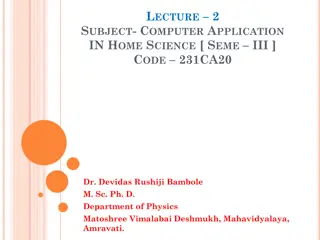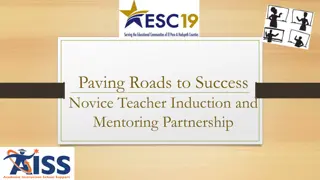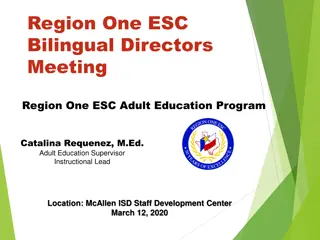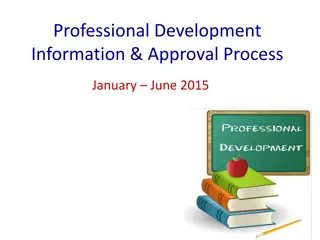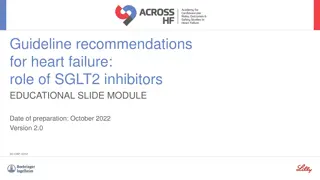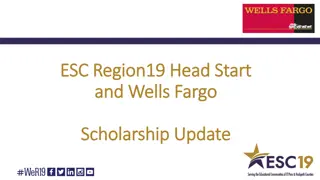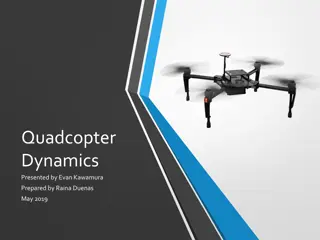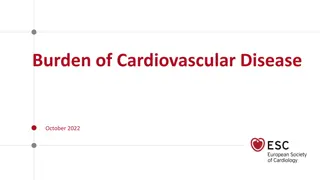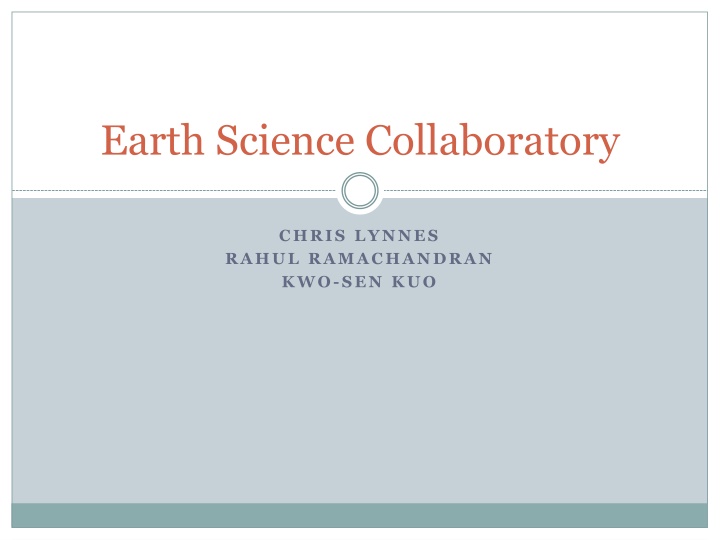
Revolutionizing Earth Science Collaboration for Enhanced Data Analysis
In the Earth Science Collaboratory, interdisciplinary researchers aim to tackle the challenges of using Earth science data effectively. With a proposed rich data analysis environment, social collaboration, and federation, the collaboratory seeks to provide access to various Earth science data and analysis services. The rise of data-intensive science, social networking, and interdisciplinary approaches are driving the need for such collaborative platforms.
Download Presentation

Please find below an Image/Link to download the presentation.
The content on the website is provided AS IS for your information and personal use only. It may not be sold, licensed, or shared on other websites without obtaining consent from the author. If you encounter any issues during the download, it is possible that the publisher has removed the file from their server.
You are allowed to download the files provided on this website for personal or commercial use, subject to the condition that they are used lawfully. All files are the property of their respective owners.
The content on the website is provided AS IS for your information and personal use only. It may not be sold, licensed, or shared on other websites without obtaining consent from the author.
E N D
Presentation Transcript
Earth Science Collaboratory CHRIS LYNNES RAHUL RAMACHANDRAN KWO-SEN KUO
Agenda Description of Collaboratory Problem Statement Concept Expected Benefits Earth Science Collaboratory Cluster in ESIP A Science Story
The Situation Today Earth Science Stuff is (still) hard to use... data science tools / svcs analysis results knowledge about data tools analysis methods find share reuse understand put together data + data data + tool tool + tool desktop + online
Currently: Islands of data and services with selective connectivity 4 Data Center A Data Center C Data Center B 7/27/11 IGARSS 2011, Vancouver, Canada
Proposed: An Earth Science Collaboratory A rich data analysis environment that: Provides access across a wide spectrum of Earth Science data Provides a diverse set of science analysis services and tools Supports the application of services and tools to data Supports collaboration on data analysis Supports sharing of data, tools, results and knowledge Two Key Tenets Social collaboration Federation
Why Now? Rise of interdisciplinary science Increasing interest in Earth system science Rise in Data Intensive science Data exploration vs. hypothesis-driven Emergence of social networking Especially amongst the young uns
High-Level Conceptual View 7 Laboratory Notebooks (Results) Publications Workflows + Analysis Processes Mediator Tools Data Data Centers Cyberinfrastructure
The Early-Career Researcher AN ESC STORY
Stu, The Early-Career Researcher B.S. in Earth Sciences from University of Michigan Now a Master s student in Atmospheric and Oceanic Sciences at the University of Maryland Professor: Find out why MODIS Aqua and Terra aerosols are anticorrelated over Tibet. I m off on sabbatical. Stu: What? They are? Hey, wait, how do I reach you? Exit Master s thesis advisor, stage right.
Stus Story Googles MODIS Terra Aqua AOD Tibet anticorrelation Result comes back from within Earth Science Collaboratory. Click...
Click Odd, MODIS Aqua and Terra AOD are anticorrelated over Tibet for 2010 -- jpearson39, 29 May 2012 Read Journal Articles Peruse Research Notebook Rerun Analysis
Stus On His Way Checks jpearson39 s research notebook for related results Repeats jpearson39 s Correlation Map workflow with different years, filtering options, etc. Decides he really needs to look at the higher resolution Level 2 satellite swath data, not nicely gridded Level 3. Uh-oh...
Level 2 data is hard... Not geographically gridded, hard to compare Aqua v. Terra pixels... Stu searches for articles about MODIS L2 aerosols, locates a prolific author, cjones97 Starting from the most relevant article, Stu looks at the Research Notebook, then drills down on a workflow to see how the data are handled Whoa, looks like Level 2 data needs quality filtering(!), and bias correction(!!) Stu clones the workflow to get started, then modifies to meet his needs, etc. Now he still needs to match up Aqua and Terra...
Finding coincident L2 MODIS Aqua and Terra aerosols Matching up data from 2 satellites is hard and tedious Stu searches to find a coincidence tool to match Aqua and Terra aerosol values within given time and space tolerance Output is HDF Finally, Stu finds a service to make an X-Y scatterplot Input is netCDF ESC locates an appropriate HDF->netCDF converter Stu and ESC construct a workflow to matchup, filter, correct and plot MODIS Aqua and Terra aerosol values
Stu gets his result! ESC s provenance shows it to trace back to cjones97 s workflow Stu also links back to jpearson39 s original results with L3 correlation maps (easy as it is still in his ESC history) Elapsed Time with ESC: < 2 days (most of it looking at prior results) Elapsed Time before ESC: > 30 days
Lessons from the Scenario: Tool availability is a force multiplier More tools will be usable with more datasets More tools will be easier to find and more available to more users Knowledge sharing evolves from text on paper to a rich mixture of data, tools, workflows and articles A wikihow for Earth Science data analysis will emerge Incorporating live data, services and workflows ESC maintains a record of the analysis process Share, repeat, build upon analysis techniques Transparency of the process is built in
Benefits More/Better Science Cross-disciplinary + Interdisciplinary Research leveraging diverse data resources Workforce development Undergraduate, graduate students learn data analysis by example Community Engagement Scientific Transparency Cost Reduction Less effort on spent on tools Less effort spent by scientists on data management N.B.: not the only or even main point of ESC
Earth Science Collaboratory Cluster in ESIP Formed in 2011 in the Federation of Earth Science Information Partners Clusters: are informal special-interest working groups have no budget are staffed by mostly-unpaid volunteers What can clusters do? Formulate and articulate community goals Coordinate community participation Suggest solution frameworks Provide a forum for networking http://wiki.esipfed.org/index.php/Earth_Science_Collaboratory
ESC Cluster Activities Articulate the vision IEEE TGRS paper, presentations Identify resources to get closer to the vision Technologies Programs Projects People ... Participate in relevant community efforts EarthCube ...
NASA Earth Science Data Systems Working Group: ESC Reference Architecture https://wiki.earthdata.nasa.gov/display/ESDSWG/Earth+Scien ce+Collaboratory+Working+Group User Stories: http://wiki.esipfed.org/index.php/Earth_Science_Collaboratory _User_Stories Key Features: https://docs.google.com/document/d/1UpLb9KtOaWqlkiZFXj6 Ir_lPlHvJ6z8DVZYiHm-bSf8/edit?usp=sharing Killer App: https://docs.google.com/document/d/1FpANLP92QMOEUDoM -kDxjjxytdm7JRdEOWzN9t98YiQ/edit?usp=sharing
The Ecosystem Strategy: Work toward an Ecosystem, not an Architected System An Emergent, Meta-System that favors federation Emphasizes grassroots adoption The value proposition at the investigator / user level is critical to get right Emphasizes inter-system interoperability Brokering, mediation, gateways, shims, polyglot components Emphasize rules and methods to fit cooperating and competing stuff together Design Selection Pressures toward desired results Funding calls Proposal codicils (e.g., ...must be infused into collaboratory ) Guidance for working groups Recruiting desirable participants etc.
The Convergent Evolution Strategy Often, some tweaking early in a project + ongoing interactions produce results that are easier to fit together... ...But it does help to know the desired end state. ESC
Prior Art 25 Talkoot, myExperiment.org workflow sharing, virtual notebooks Earth System Grid provisioned tools, format standards/checkers NASA Earth Exchange (NEX) Land Information System OPeNDAP as access infrastructure Earth Science Modeling Framework programmatic approach to integration Giovanni, LAS community services/tools Canadian Space Science Data Portal (EOS, Feb. 22, 2011) HubZero 7/27/11 IGARSS 2011, Vancouver, Canada
Tool Library 26 Discovery Social oSharing oTagging oDiscussion Configuration Management oTesting oVersioning PROVISIONED GrADS IDL MatLab ncl nco cdat CONTRIBUTED [Tool 1] [Tool 2] [Tool 3] [Tool 4] [Tool 5] Packager autoconf RPM Web wrapper COMMUNITY Quality filter Coincidence Feature detection Event service Visualization PERSONAL [Tool 1] [Tool 2] [Tool 3] [Tool 4] [Tool 5] 7/27/11 IGARSS 2011, Vancouver, Canada
Data Library 27 Cache Discovery Social oSharing oTagging oDiscussion Configuration Management oTesting oVersioning PROVISIONED EOSDIS CONTRIBUTED [Dataset 1] [Dataset 2] [Dataset 3] [Dataset 4] [Dataset 5] Packager data probe format check metadata wizard COMMUNITY Field campaigns MEaSUREs ACCESS Validation PERSONAL [Dataset 1] [Dataset 2] [Dataset 3] 7/27/11 IGARSS 2011, Vancouver, Canada
Workflow Library 28 Discovery Social oSharing oTagging oDiscussion Configuration Management oTesting oVersioning PROVISIONED Processing Algorithms CONTRIBUTED [Workflow 1] [Workflow 2] [Workflow 3] [Workflow 4] [Workflow 5] Packager Workflow editor COMMUNITY GeoBrain SciFlo Data Mining Giovanni PERSONAL [Workflow 1] [Workflow 2] [Workflow 3] 7/27/11 IGARSS 2011, Vancouver, Canada
Laboratory Notebook 29 Discovery Social oSharing oTagging oDiscussion Configuration Management oVersioning PROVISIONED Tutorials User guides Example uses Educational packages PROJECT [Project 1] [Project 2] [Project 3] [Project 4] [Project 5] Packager Project Manager Experiment manager Notebook editor COMMUNITY Project results Publications Example cases Educational packages PERSONAL Notes Journals 7/27/11 IGARSS 2011, Vancouver, Canada
Mediator 30 Mediates tool interaction with data OPeNDAP a common data model (accessible by most tools) Custom modules reformat data for the rest of the tools Ontology matches tools with data, and vice versa. 7/27/11 IGARSS 2011, Vancouver, Canada
Cyberinfrastructure Services used by all other components Security authentication authorization code audit/padded cell integrity checking Social tagging sharing discussions groups reputation Cloud elastic provisioned storage and computing Discovery data, tools, workflows, experiments search by keyword, variable, time, author Information Mgmt provenance identifiers archive Semantic Web data ontology tools ontology

